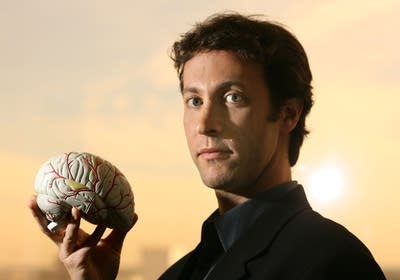Ask a Neuroscientist: How and where are memories stored?

This is the second in an occasional series called 'Ask a Neuroscientist.' We're taking audience-submitted questions to David Eagleman, a neuroscientist at Baylor College of Medicine in Houston, to learn more about how the brain works.
Dan in Columbia Heights: Is there any kind of theory on where/how memories are stored?
David Eagleman: In the 1920s a scientist named Lashley thought he could figure out exactly where memories were stored, so he trained rats to run around a maze. And once they learned -- once they had a memory of the maze -- he would make small bits of damage to various parts of their brains to find out where the memory is stored. And what he discovered is it's not stored in any one spot. In other words, memory is distributed -- there's no single region in the brain that's sort of 'the memory region' -- where you might get damage and suddenly your memory is disappeared.
Aside from being distributed, the other thing that's becoming clear about memory is that it's not even one thing that we're talking about. So, for example, there's a distinction between short and long-term memory. These have completely different ways of being stored in the brain. Short-term memory is stored in activity in the brain; if I told you to remember some phone number and go dial it across the room, you're keeping that active in your mind through active processes in your brain.
Create a More Connected Minnesota
MPR News is your trusted resource for the news you need. With your support, MPR News brings accessible, courageous journalism and authentic conversation to everyone - free of paywalls and barriers. Your gift makes a difference.
Long-term memory -- the name of your third grade teacher -- is stored in the structure of your brain. When you learn something new, there's actually a physical change in your brain-- and so exactly what those changes are -- that's an area of active research that's ongoing.
But what's clear is short- and long-term memory are very different, and there are even different types of long-term memory. For example, those things you can explicitly declare: Your name, or what you had for breakfast, or when the Battle of Hastings was. And then there are things that are implicit, like how to ride a bicycle. That counts as a memory - your brain has absorbed that information and retained it, it's just you can't say anything about it.
Tom Weber: I can remember growing up and watching a cartoon and they went to a shot of a guy's brain -- like what does the brain look like -- and it was a room of file cabinets, and each file was his memories. And I've always has that in my head that that's what's going on in the brain, but it sounds like the files are strewn across the desk, more than in a file cabinet.
Eagleman: It turns out it's stranger than that. It's nothing like file cabinets or computers. Mother Nature has a completely different strategy than we humans have come up with. One of the secrets of memory is that things aren't stored as files or facts, they're stored in relation to other things.
So if there's a song you know -- the national anthem -- I can transpose the key, so now it's in different notes, and yet you'll recognize it. Why? It's because you're not storing the file of the song, it's the relation of the notes. That's what makes the song the song, even as individual pitches change.
Or when you recognize my face: There's the distance between my eyes, and the length of my nose, and the shape of my mouth. All these things in relation to each other-- if you see me a year later and I have some scruff, or a suntan, you'll still recognize me immediately. A computer that's just working with some filing system of zeroes and ones -- computers fail miserably at this sort of task, and this reveals one of the secrets of the way in which human memory is the way we think about traditionally storing data.
